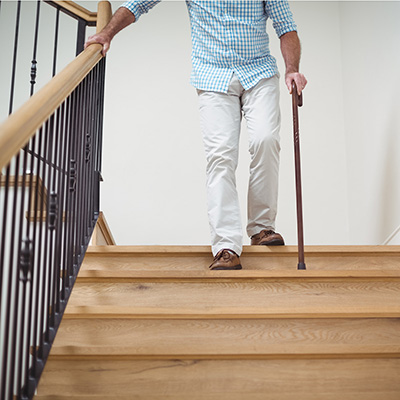Vitality eNews Sign Up
Receive the Summa Health eNewsletter for the latest health tips, advice and updates.
Neurological Disorders: Take Strides To Reduce Your Fall Risk
Posted July 18, 2022 by Hasan Askari, M.D.

Falls are an unfortunate, yet frequent complication for people with neurological disorders. From Parkinson’s disease and Diabetes Mellitus to neuromuscular disorders, and from brain tumors to multiple sclerosis, neurological disorders affect the brain and central nervous system. This can cause paralysis, muscle weakness, poor coordination, loss of sensation, pain and much more.
Because of the mobility challenges, instability and other symptoms, people with neurological disorders may be at an increased risk for falls and the potentially life-changing consequences of fall-related injuries.
The good news is there are things you can do to reduce your risk. Although completely eliminating falls is unrealistic, you can identify your key risk factors and take strides to minimize them.
Summa Health offers three steps patients with neurological disorders can take to keep steady on their feet and reduce their risk for falls and fall-related injuries.
Talk to your neurologist to minimize your fall risk
Talk to your neurologist and discuss any symptoms that may be contributing to your increased fall risk. If those symptoms are not well managed, ask your doctor for ways to minimize them.
In addition, there are some medications that can affect your brain and sensory function. Sleeping pills and sedatives can affect coordination. Some blood pressure medications can cause blood pressure drops upon standing and increase your fall risk and some antibiotics can damage the inner ears, creating balance problems.
If you have concerns about your current medications — both prescription and over-the-counter — discuss them with your doctor. Together, you can assess the benefits and potential risks of necessary medications.
Also, keep a complete list of all your medications and dosages, so your doctor has a full picture of what you’re taking and can help you avoid adverse drug reactions to the brain and sensory function.
Get evaluated by a professional
Seek out medical professionals who specialize in comprehensive treatment for balance management. Physical therapy that addresses balance and strengthening has been shown to reduce a person’s risk for falls. A physical therapist can identify problem areas and develop an exercise routine that can be effective in helping to reduce falls and fall-related injuries.
The important thing is to not only meet with a physical therapist, but also that you perform the home exercises to improve your balance and strength.
Inactivity can result in the loss of muscle tone and weakness, as well as poor posture and impaired balance. Even simply going for a walk regularly can improve strength, muscle tone and coordination.
If sustained and long-term fall prevention care is required or if you need short-term treatment of gait deficit caused by a neurological condition, seek a neurologist who specializes in fall prevention and balance restoration. After a gait-related clinical evaluation, you will be presented with treatment options to correct instabilities.
Eliminate environmental risk factors
Eliminating hazardous conditions in your physical environment and daily activities is an important strategy for fall prevention.
Reduce risk in your home by:
- Installing grab bars and nonskid tape in your tub and shower. Use nonskid bath mats or install carpet in the bathroom. If necessary, use shower chairs and bath benches to minimize fall risks.
- Making sure hallways, stairwells and rooms are well lit. Install nightlights in your bathrooms and hallways to illuminate pathways. If you need to get up in the middle of the night, turn on a light so you can see where you’re going.
- Securing treads, rails and area rugs. Make sure area rugs are anchored to the floor and smooth. Also, install a handrail on both sides of the stairwell. If stairs are a threat, avoid using them by bringing all your necessities to one floor.
- Removing raised doorway thresholds in all rooms. Also, rearrange furniture to keep electrical cords and furniture out of walking paths, and get rid of clutter.
Paying close attention to your environment and navigating carefully are the most effective ways to prevent injuries. Wearing sturdy shoes with good traction is also helpful. It may be necessary to use a mobility aid such as a cane, walker or scooter especially on uneven ground or in unfamiliar surroundings.
These are things you can do now to reduce your risk of falling. Don’t wait until it’s too late. If you're at risk for falls, schedule an appointment with Summa Health's Fall Prevention and Balance Restoration Clinic by calling 330.375.7055.
